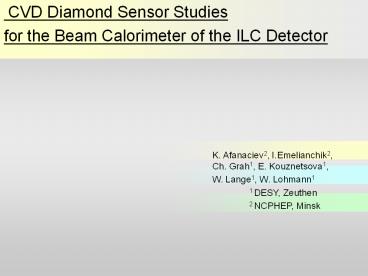CVD Diamond Sensor Studies - PowerPoint PPT Presentation
Title:
CVD Diamond Sensor Studies
Description:
detection and measurement of high energetic electrons and photons at very small angles ... absolute intensity measurement (Thermoluminescence dosimetry) ... – PowerPoint PPT presentation
Number of Views:51
Avg rating:3.0/5.0
Title: CVD Diamond Sensor Studies
1
CVD Diamond Sensor Studies for the Beam
Calorimeter of the ILC Detector
K. Afanaciev2, I.Emelianchik2, Ch. Grah1, E.
Kouznetsova1, W. Lange1, W. Lohmann1 1 DESY,
Zeuthen 2 NCPHEP, Minsk
2
Beam Calorimeter
m-
s 102 fb (SPS1a)
- BeamCal (4-28) mrad
- fast beam diagnostics
- detection and measurement of high energetic
electrons and photons at very small angles
s 106 fb
3
Beam Calorimeter Requirements
ILC bunch small size high charge -gt
beamstrahlung
- 15000 ee- per BX (30 60 TeV)
- 10 MGy / year for some area
- gt
- radiation hard material
- with small Moliere radius
-gt high energy deposition in the Beam Cal
Diamond/Tungsten sandwich
4
pCVD Sensor Measurements
- Requirements
- - stability under irradiation
- - linearity of response
- Samples
- Fraunhofer IAF, Element Six
- 12x12 mm2, 300-900 mm
- Measurements
- Current-Voltage characteristics
- Charge Collection Efficiency
- Qmeas/Qcreated CCD/L Qcreated(MIP) 36
eh/mm - Irradiation tests (up to 100 Gy)
- Linearity measurements
5
pCVD Sensors Irradiation Measurements
6
pCVD Sensors linearity test
- Hadronic beam, 3 5 GeV
- (CERN PS)
- Fast extraction mode
- 104-108 / 10 ns
7
Linearity test wide intensity range
relative intensities estimated from PMTs (1-
600)
absolute intensity measurement
(Thermoluminescence dosimetry)
8
PMT calibration
9
Back to the testbeam data
HV(PMT)
L
R
intensity
absolute calibration for one of the runs 1 RI
(27.3/-2.9) 103 MIP/cm2
10
Linearity of diamond response
E64
FAP2
11
Conclusions
- The covered range
- the particle fluence up to 107 MIPs per bunch
- The obtained deviation from a linear response
- 30 - at the level of systematic errors of
the fluence calibration

